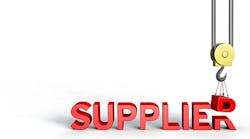Twenty-five years ago supplier development was the hot topic in supply management. Corporations were starting to staff-up and offer assistance in improving supplier manufacturing efficiency. It wasn’t unusual for large original equipment manufacturers (OEMs) to have dozens of supplier development personnel assigned to support supplier improvement efforts. The OEM I worked for had—at its height—almost 100 such resources. Today, not so much. So what happened?
It’s not so hard to understand. Remember, in the 1990s the concept of supplier development had to go up against the tide of sourcing to low-price countries. I can remember very vividly as a newly-minted manager having been charged with rolling out the supplier development initiative within my division, presenting my plans for its development to a group of executives—and, as it happened, a couple of Brooks Brothers-clad consultants who were at the time reviewing our supply management function. One of those “suits,” in fact, interrupted me in mid-presentation by saying he had never heard anything more stupid (his words). He went on to say there was really no need to expend resources on incumbent suppliers when “what was needed was to start sourcing in China and India” to get lower prices. I didn’t even get to finish my presentation. Did I mention that the “suits” were also wearing wing-tips?
Fortunately, after the meeting, one of the attending executives told me to continue on with my efforts and, as they say, the rest is history. (If you’re interested in reading about what supplier development eventually ended up delivering to my corporation, please refer to the article “Lean’s Trinity” from Industrial Engineer magazine.)
Unfortunately, in the end, what the consultants were calling for won out. Large corporations heeded the call to source overseas in almost a lemming-like way, in the end deciding that lower piece-prices were the primary goal of supply management and they would best be obtained by sourcing to low-price (note, not necessarily lowest total cost) countries. Supplier development—where it continued at all—was for the most part delegated to minor functions.
The overriding goal of Next Generation Supply Management is development of a world-class supply base. As discussed above, most procurement executives of my generation translated that goal to a pursuit of world-wide supply chain with the singular goal of improving material variance. I don’t think that too many people today will argue that overseas sourcing hasn’t yielded the world-class performance we were after in our suppliers.
For instance, overseas sources have inherently lengthy Manufacturing Critical-path Times (MCTs). Building to demand (or otherwise changing schedule on short notice) is pretty difficult when suppliers have MCTs (true lead-times) of (at best) two to three months. In fact, I’ve seen plenty of contracts with overseas sources that required a “90-days firm” schedule commitment. Add to that four to six weeks of transportation and you’ve got an almost six-month period of supplier order fulfillment inflexibility.
The only way to make this arrangement support varying market demand is to have pre-built purchased inventory “on hand” which, of course, is an indicator of anything but a world-class source. So perhaps supplier development deserves another look as a vehicle for achieving that world-class supply base goal. But let’s first look at what most companies that do maintain a supplier development function are using it for.
Small/Disadvantaged Supplier Support
Small/disadvantaged suppliers typically are those whose majority ownership is represented by protected classes, such as veterans, women and minorities. To promote economic participation by these classes the federal (and some state) purchasing agencies require OEMs to acquire a minimum percent of their purchased content from them for the products they wish to sell under governmental contracts.
My experience is that small/disadvantaged suppliers are often short on money and/or technical expertise and because of this finding enough competent ones to support this sourcing requirement can be difficult. For many companies, the role of supplier development is to make sure that enough of such capable suppliers exist such that the OEM’s product can qualify for government contracts.
This role is not a bad one but it certainly can’t be called significant in the big-picture scheme of company procurement.
Supplier Order Fulfillment Failures
When a supplier cannot support orders due to quality problems, lack of capacity, etc., and that negatively affects an OEM customer’s product schedule, we used to refer to that as a “drop everything” situation. In these instances, many corporations offer supplier development support to help get the supplier back to a position where they are able to support the schedule. In other words, supplier development takes on the role of a fire-fighter.
Again, it is difficult to argue for the need of this but (hopefully) it can’t be called significant in the big-picture scheme of company procurement.
Supplier Price Reduction Shortfalls
Many OEMs have annual price-reduction expectations. When suppliers can’t meet them, OEMs often offer supplier development assistance. In these situations the sole goal of this support is to find ways a supplier can reduce their prices. I won’t argue with this role either but I know first-hand that it puts the supplier development in the position of needing to look for quick-hit improvements rather than sustainable fixes that are in the best interests of the supplier’s overall business since these normally take a longer effort.
I’ll add that in this role supplier development personnel are typically looked upon as anything but benevolent by suppliers who more often than not see their support as looking for ways to cut margins. I once overheard a supplier discussing their supplier development experience as “a Gestapo-type interrogation.” I don’t think this reaction is rare. How collaborative do you think suppliers with this perspective will be in working with their supplier development “white knights”?
What the Supplier Development Role Should Be
Supplier development should have the role of assuring that strategic suppliers are working their way towards becoming world-class. Supplier development support shouldn’t be offered to suppliers of commodities or things that can be easily resourced. Instead, the function should play an integral role in the overall supply management strategic goal of ensuring that suppliers the OEM is depending on are moving towards becoming world-class. And the focus of the supplier development effort should be sustainable manufacturing efficiency improvement, not piece-price reduction.
The point here is that supplier development should not be seen as a vehicle for short-fuse price reductions. Of course, as a supplier moves towards world-class performance, costs will go down. But it should be the buyer’s responsibility as part of the normal management process to translate these costs down into better pricing.
I know that such a position doesn’t fit into the quarterly buyer performance metrics, but maybe with strategic suppliers those metrics (and how that category of suppliers is managed) need to change. Using supplier development to get immediate price reduction gratification will likely cause the supplier to regard supplier development support as a Gestapo-type intervention which will be counter-productive over time. But trust me here—once supplier development support gains critical mass at a supplier, it leads to ongoing improvements in cost/price.
You may ask, “Why do OEMs need to provide suppliers with industrial engineering support?” Good question. My answer is that over time OEMs have driven many of their suppliers to become anorexic rather than Lean, and that engineering resources are one of the first things that suppliers cut when trying to keep an important customer’s business. So to be pragmatic, you provide the support suppliers need for them to help you meet your company’s goals.
The next few columns will drill down deeper into examining what supplier development can mean for a supply management function if executed properly, and also give you some tips on how not to do it.





